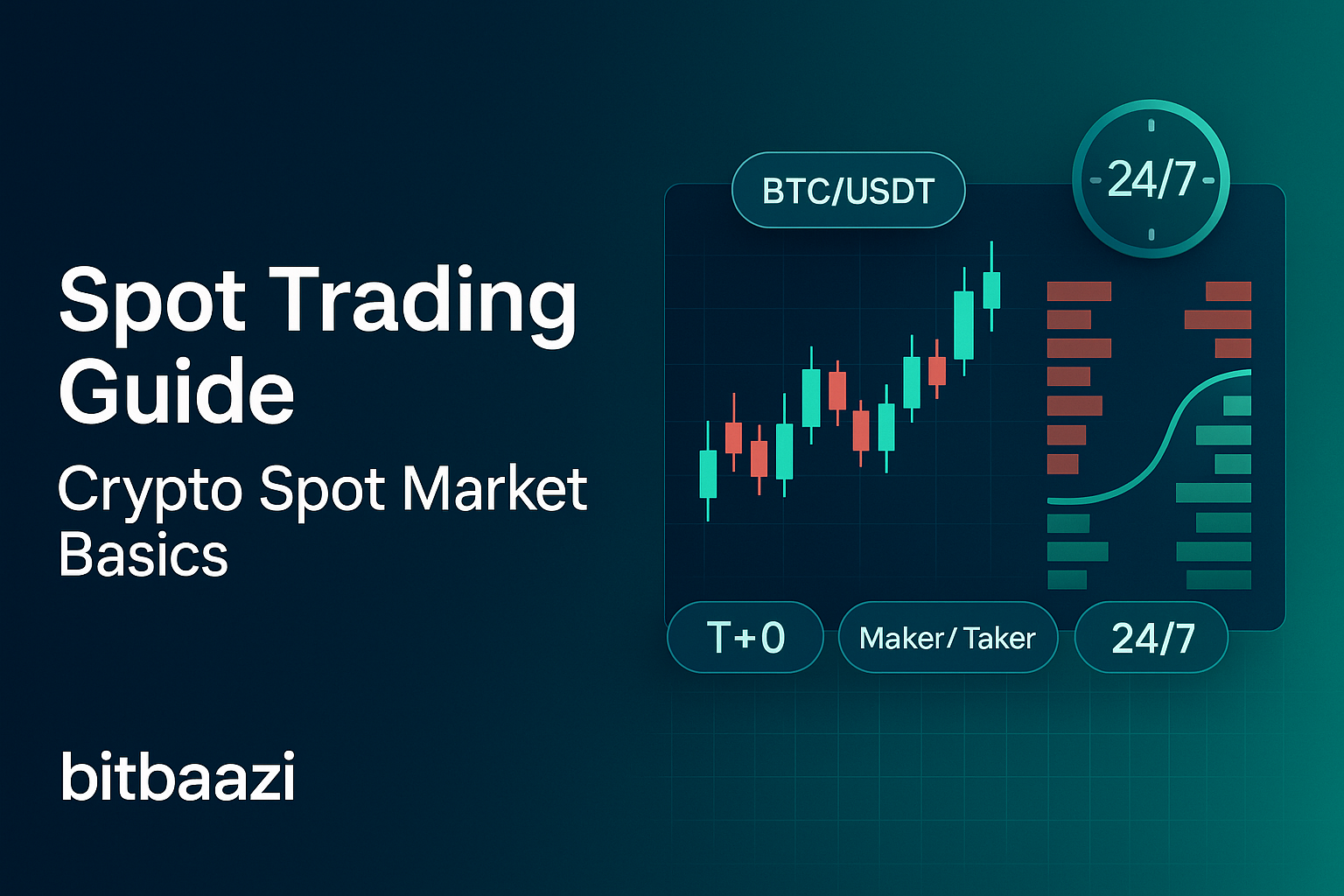Summary
• Spot markets trade assets for immediate delivery (T+0).
• Orders match on an order book; fees follow maker/taker logic.
• Risks run 24/7; custody and sizing matter more than speed.
Crypto’s simplest market is where assets change hands for cash or another coin now. This guide explains Spot Trading without leverage, how orders set the price, and how to operate safely across T+0 settlement and 24/7 conditions.
What a spot trade does
A spot trade exchanges assets at the current price for immediate delivery.
Settlement is T+0 by design, so the bought asset enters your account once matched. Pairs like BTC/USDT quote the base asset (BTC) in the quote asset (USDT), and trades clear as orders meet. Because there’s no leverage, you can only trade what you hold, limiting liquidation risk while preserving market exposure.
Order types, fees, and price formation
Orders meet on an exchange order book, forming the real‑time spot price.
Limit orders post liquidity and may earn lower “maker” fees, while market orders remove liquidity and pay “taker” fees. Price discovery happens where bids and asks cross; depth affects slippage, especially in fast moves. Watch minimum tick sizes and lot sizes that govern how small you can quote or trade each pair.
How to trade spot safely
Use clear order types, modest size, and sound custody before you scale up.
Start with a small limit order to validate routing and fills. Confirm the trading pair and fee tier, then monitor fills against quotes to understand slippage. Because markets run 24/7, set alerts and avoid fatigue trading. For custody, enable 2FA, segregate long‑term holdings from hot wallets, and verify addresses on any withdrawals. This is operational hygiene, not investment advice.
FAQ
Is settlement instant on spot markets (T+0)?
Most venues credit fills immediately (T+0). Final blockchain transfers depend on the asset’s confirmations and your withdrawal choices.
Why do maker/taker fees differ?
Makers add to depth and are often incentivized with lower fees; takers remove liquidity and pay more because they consume depth.
How do I read BTC/USDT quotes?
BTC is the base; USDT is the quote. The number shows how many USDT per 1 BTC at that moment on the book.
Do spot risks pause overnight?
No. Crypto trades 24/7, so gaps can occur any time; use alerts and size prudently.
Takeaways
- Trade only what you hold; no leverage means fewer liquidation paths.
- Prefer limit orders when learning; track fills and slippage.
- Separate trading funds from long‑term custody; keep 2FA on.
- Know fees, lot sizes, and tick sizes before submitting orders.
作用与流程
现货交易以当前价格成交并在T+0完成交割。
买入或卖出在订单簿上撮合,一旦成交资产立即计入账户。以BTC/USDT为例,BTC为基准资产、USDT为计价资产,价格显示“1 BTC 等于多少 USDT”。本文聚焦无杠杆撮合与交割流程,并强调在24/7市场中的执行与风控要点。
订单类型、费用与价格形成
订单在撮合引擎汇合,形成实时现货价格。
限价单提供流动性,通常对应“maker”费;市价单吃单,对应“taker”费。深度决定滑点,极端波动时更明显。务必留意最小变动价位与最小下单数量,它们限定报价粒度与下单规模。
安全步骤
先用小额限价单验证流程,再逐步扩大规模。
下单前确认交易对、费率档位与最小数量;成交后核对成交均价与滑点。由于市场24/7运行,建议设置价格提醒并避免疲劳交易。资金托管方面,启用2FA,将长期持仓与热钱包分离;本文不构成投资建议,仅为操作与风险提示。
現物取引のしくみ
現物はその時点の価格で約定し、T+0で受け渡しされます。
注文は板でマッチングされ、約定した資産が口座に反映されます。BTC/USDTのように、BTCがベース資産、USDTが見積資産です。レバレッジを使わない撮合と受渡しの基本、そして24/7市場での実務ポイントを整理します。
注文種別・手数料・価格形成
板で注文がぶつかり合い、実勢のスポット価格が作られます。
流動性を供給する指値は“maker”手数料、板を消費する成行は“taker”手数料が一般的です。板の厚みはスリッページを左右し、急変時ほど影響が大きくなります。最小ティックと最小発注数量も確認し、誤発注を防ぎましょう。
安全な進め方
小さな指値注文で動作確認し、段階的にサイズを上げます。
発注前にペア、手数料、ロットを確認し、約定後に実効価格と滑りを検算します。市場は24/7のため、通知設定と休息の確保が重要です。資産管理は2FAを有効化し、長期保有と取引用を分離してください。本稿は投資助言ではなく運用上の留意点です。
